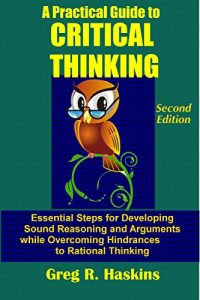This eBook presents a concise treatise of critical thinking, embodying its most important elements into a compact, convenient, organized, and easy to understand form. It is intended as a handy go-to reference source to help anyone or any organization develop sound reasoning and arguments. Key elements include:
•What critical thinking is (and is not), its uses and its limitations
•How critical thinking relates to the human understanding process
•The five steps to becoming a critical thinker
•An argument checklist
•Five appendices of critical thinking hindrances (biases)
The original “A Practical Guide to Critical Thinking” was hosted on skepdic.com beginning in 2004. Since that time it has become internationally adopted or referenced by educational institutions, medical institutions, militaries, government agencies, blogs, and newsletters as a handy guidebook on critical thinking. This second edition, now available at a modest price, has been updated to include a new appendix on hindrances due to natural biases (Appendix 5). Additionally, the entire guidebook has been reformatted as an eBook. As such, the tables of critical thinking hindrances have been converted to appendices to make them legible on various reading devices. Please note that the formatting of paragraphs may appear different depending on the eBook reader used.
•What critical thinking is (and is not), its uses and its limitations
•How critical thinking relates to the human understanding process
•The five steps to becoming a critical thinker
•An argument checklist
•Five appendices of critical thinking hindrances (biases)
The original “A Practical Guide to Critical Thinking” was hosted on skepdic.com beginning in 2004. Since that time it has become internationally adopted or referenced by educational institutions, medical institutions, militaries, government agencies, blogs, and newsletters as a handy guidebook on critical thinking. This second edition, now available at a modest price, has been updated to include a new appendix on hindrances due to natural biases (Appendix 5). Additionally, the entire guidebook has been reformatted as an eBook. As such, the tables of critical thinking hindrances have been converted to appendices to make them legible on various reading devices. Please note that the formatting of paragraphs may appear different depending on the eBook reader used.






